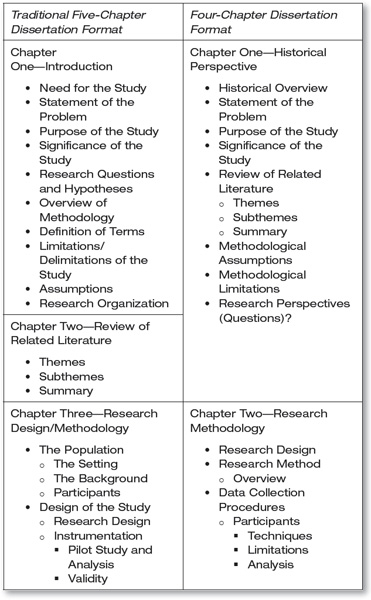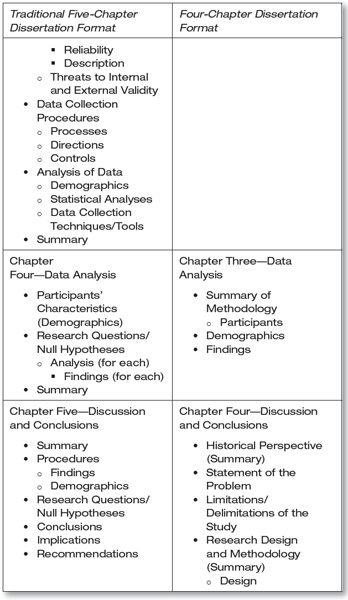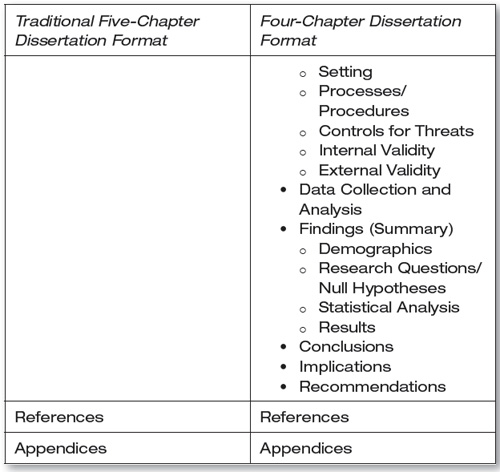
Often, dealing with institutional requirements may be frustrating. This frustration may be the result of a lack of understanding or simply taking the time to become familiar with the institution’s requirements for the research document. In general, you become so involved in your research that you may forget about the guidelines set forth by the institution regarding the degree completion requirements. The knowledge of institutional requirements will help facilitate a positive experience and successful completion of the research study.
The style of the study may be institution specific, department specific, or dissertation chair specific. Regardless of the style, the information included in the study and the rigor of the study remain unchanged.
In terms of a specific style, for example, the dissertation may be completed using a traditional five-chapter model or a nontraditional four-chapter model. Both styles contain the same information with a slight variation of content within the chapters. For example, in the four-chapter dissertation style, Chapter One would include similar information as Chapters One and Two in a five-chapter dissertation style (see Exhibit 2.1).
Institutions of higher education have specific guidelines outlining how theses and dissertations are to be formatted and submitted as well as deadlines regulating what needs to transpire at certain intervals during the process.
All the specific information may be typically found within a graduate school’s handbook, and it should also be available from the specific department in which you are studying for the degree.
Formatting. The institution usually follows a preferred style as dictated by guidelines set forth by organizations such as the American Psychological Association (APA), the Modern Language Association (MLA), and the Chicago Manuel of Style (CMS). Each of these styles of writing offers a unique way of formatting text, margins, fonts, and text style. Each of the aforementioned organizations may have specific information accessed via the Internet as well as by your local bookstore and/or university student bookstore.
Submission. The submission of your study is also specific to your institution’s guidelines. There are two formal submissions: the proposal defense and the final defense. The proposal defense serves as a formal presentation of your work outlining how you propose to conduct the study. Typically, most institutions and/or specific departments require a minimum of two-week notification to the university community.
Exhibit 2.1 Comparison of Dissertation Formats



The final defense has several additional submission requirements; the document is approved by various officials within the department and the university. For example, once the study has been formally approved by your dissertation committee, all revisions are completed, and it has been signed by your dissertation chair, the study is submitted to the chair of the department in which your degree resides for his or her approval. The chair of the department then approves the document and forwards it to the graduate school for approval of the graduate school dean. The graduate school dean approves and notifies the student that all approval signatures have been obtained and the document is thereby accepted by the institution and ready for submission to the institution’s organizations for completed studies (i.e., university library, ProQuest, respective department). Again, knowing beforehand expectations of the institution’s submission process is important so that you will be able to facilitate a smooth study closure.
Universities that require Institutional Review Board (IRB) training and approval are commonly associated with institutions that have health-related schools and/or colleges as well as the social sciences including psychology, sociology, and anthropology. The purpose of the IRB training and approval process is to inform researchers of best practices in research methods related to the protection and welfare of the study participants as well as the investigator(s).
All research studies conducted at institutions require IRB approval of the study. This approval must be obtained by the investigator(s) before they may collect any data. Each institution has a formal IRB approval process that is required at the beginning of the study and at the conclusion of the study.
With most research studies, the student, in consultation with and with the approval of his or her study chair, will submit the IRB approval form to the chair of the department in which the degree resides for the department chair’s approval. Once the study has been approved at the department level, the study is forwarded to the IRB office for review and approval. Typically, the approval process takes approximately two weeks depending on the structure of the institution’s IRB meetings and reviews process. This approval time line has been shortened quite a bit by institutions that have implemented an electronic approval process. Therefore, all forms (signatures/approval) are transmitted electronically resulting in a decrease of “lag” time created by campus mail systems.
Once the research study has been completed, the principal investigator has up to six months to submit an IRB “closure” form to the respective institution’s IRB office. This IRB closure form is notification to the IRB office that the study has been completed and there no longer exists a need to continue examining the research question(s).
On a related note, if the study needs to remain open for an extended amount of time or if the nature of the submitted study protocol needs to be changed, then an IRB submission noting a review of the proposal must be submitted for continued approval so that you may continue to collect and analyze data.
The knowledge and training acquired by participating in the IRB training modules is important to understanding the ethical treatment of participants as well as the access and storage of data collected. As a student, I think the most valuable “oh hey” moment is the realization and understanding that the IRB process is meant to protect the researcher and participants. With this mind-set, the entire IRB process fits into a more logical and meaningful experience.
The IRB registration and tracking for training has greatly improved over the past years. Presently, students may access the website provided by their respective institution to register their IRB account. Typically, this registration is at no cost to the student. Once you have registered, you will be assigned an IRB number. You may use this number to stay updated on your certification and history of IRB training.
The initial IRB certification training consists of five online content modules. Each module is content specific, and the complete training covers topics ranging from the treatment of subjects to the collection and storing of data. At the end of each module, a test is provided that relates to the specific content covered within that module. Students are required to answer a set of multiple choice questions. You must score a minimum of 80 percent correct on each module to receive credit for the module and thus receive the certification to conduct a research study.
Upon successful completion of the training modules, you will receive a certificate of which you may print a hard copy. You may also access your file by using your IRB number to view when you last completed the certification modules.
Once you receive this IRB certification, it does not mean that you are never required to participate in ongoing training. In fact, the certification expires after a specific time interval, which we will discuss in the next section. At a point in time when you need to update your certification, you simply access the IRB website and input your IRB number; this will access your IRB personal site so that you may review your specific information. Because you need the “refresher” IRB training, you follow the links that will access those training modules. The IRB refresher module training is not as in-depth or as lengthy as the initial IRB training certification. This recertification allows for updates and best practices in research and serves as a valuable update of information.
The IRB certificate time frame is three years. Therefore, if you continue to engage in active research or it takes you longer than three years to complete your study, you must update your certification (per the discussion in the previous section). Unfortunately, the IRB site will not notify you of the expiration of your certification; you must find a way to remember this frame so that you are not caught in an awkward situation of engaging in research without being certified to do so.
Before beginning your graduate program of study at an institution, it is wise to ascertain the institution’s program completion time limit. This information is important as you map your program of study requirements concerning coursework and research to your personal and professional obligations. The degree time limit may help you focus and plot your strategy within the allotted amount of time so that you may know your commitment required and gain valuable experience associated with the program.
Institutions vary on the length of time of degree completion. Generally, most institutions’ degree completion timelines range from a minimum of six years to a maximum of ten years. Also, with most institutions, there is some flexibility within the time line requirements to allow for time extensions if needed. For example, an institution with a six-year degree completion time line may allow for two one-year extensions without you having to do anything other than submit a request for the extension along with a valid reason. For the most part, time extensions likely to be considered, and approved, by the institution are for issues such as illness, change of job, or other personal or professional life challenges that may have prevented someone from completing the degree within the required time.
Therefore, knowing the parameters of the degree completion time line along with instances of time extensions serve as valuable information to know regarding the degree program and institution requirements for degree completion.